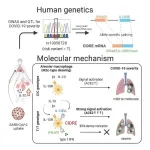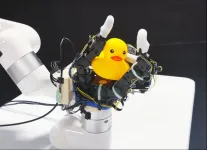(Press-News.org) Researchers have created a robot capable of conducting experiments more efficiently and sustainably to develop a range of new semiconductor materials with desirable attributes. The researchers have already demonstrated that the new technology, called RoboMapper, can rapidly identify new perovskite materials with improved stability and solar cell efficiency.
“RoboMapper allows us to conduct materials testing more quickly, while also reducing both cost and energy overhead – making the entire process more sustainable,” says Aram Amassian, corresponding author of a paper on the work and a professor of materials science and engineering at North Carolina State University.
Conventional materials research requires a researcher to prepare a sample and then go through multiple steps to test each sample using different instruments. This involves placing, aligning and calibrating samples as needed to collect the data. Think of it as an assembly line that is both time consuming and requires a lot of electricity to power the relevant instruments.
Previous efforts to automate this process have relied largely on automating the assembly line with one sample per chip moving through the entire data collection process. This improves speed, but each of the steps still has to be done with one sample at a time.
“RoboMapper also automates this process, but places dozens of samples on each chip by miniaturizing the material samples with the help of modern printing,” Amassian says. “It still performs each step of the data collection process, but it does so for multiple materials in parallel, saving time and energy.”
“This makes searching for new materials far more efficient, more cost effective, and more sustainable in terms of our carbon footprint,” says Tonghui Wang, lead author of the paper and a Ph.D. student at NC State. “It’s nearly 10 times faster than previous automated techniques.”
To confirm this, the team evaluated the environmental impact of traditional materials research and data collection and compared it with the RoboMapper.
“It was remarkable to find that characterization is the major source of greenhouse gas emissions in materials research,” says environmental economist Lucía Serrano-Luján, co-author of the paper and a researcher at Rey Juan Carlos University and the Technical University of Cartagena. “The RoboMapper’s ability to streamline the data collection process by placing dozens of materials on the same chip reduced greenhouse gas emissions tenfold.”
To demonstrate the utility of RoboMapper, the researchers focused first on perovskite materials. Perovskites, which are defined by their crystalline structure, are better than silicon at absorbing light. That means perovskite solar cells can be thinner and lighter than silicon solar cells without sacrificing the cell’s ability to convert light into electricity – making them a focal point for research into next-generation solar technologies.
Specifically, the researchers focused on perovskite stability, which is one of the biggest challenges in the field.
“Basically, the challenge is that perovskite materials tend to degrade when exposed to light, losing the properties that made them desirable in the first place,” Amassian says. “We’re looking for ways to engineer these materials so that they are stable – meaning they retain their desirable properties for a long time, even when exposed to light.”
And the researchers had their first significant finding with RoboMapper during the technology’s proof-of-concept demonstration.
The researchers tasked RoboMapper with making alloys using a defined set of elements. RoboMapper then made samples with 150 different alloy compositions and conducted optical spectroscopy and X-ray structural assessments and stability tests of those samples.
RoboMapper’s tests were designed to identify whether an alloy was suitable for tandem solar cells, meaning: whether it had the crystalline structure of a perovskite; whether it had a desirable set of optical characteristics, known as the band gap; and whether it was stable when exposed to intense light. This experimental data was then used to construct a computational model that identified a specific alloy composition that it predicted would have the best combination of desired attributes.
The researchers then made the desired alloy with RoboMapper and by using conventional laboratory techniques, and tested both.
“We are able to quickly identify the most stable composition from a possible set of perovskite alloys at a target band gap using the specific suite of elements we confined ourselves to for this proof-of-concept work,” Amassian says. “The material we identified using RoboMapper also turned out to be more efficient at converting light into electricity in solar cell devices. Our conventional techniques validated the results from RoboMapper.
“One reason RoboMapper’s experiments were able to produce such useful data is that the specific suite of experiments we used is based on previous work that informs our understanding of the relationship between what we can observe in optical tests and the stability of perovskite materials.
“Next steps for this work include expanding the range of potential alloys for testing in RoboMapper,” Amassian says. “We’re open to working with industry partners to identify new materials for photovoltaics or other applications. And with support from the Office of Naval Research, we are already using RoboMapper to advance our understanding of materials for both organic solar cells and printed electronics.
The paper, “Sustainable Materials Acceleration Platform Reveals Stable and Efficient Wide Bandgap Metal Halide Perovskite Alloys,” will be published July 25 in the journal Matter. Study co-authors include Hossein Ardekani and Robert Epps, former Ph.D. students at NC State; Jiantao Wang and Mahdi Ramezani, former postdoctoral researchers at NC State; Ryan Wilmington, Kasra Darabi and Boyu Guo, Ph.D. students at NC State; Mihirsinh Chauhan, a postdoctoral researcher at NC State; Dali Sun, an associate professor of physics at NC State; Milad Abolhasani, a professor of chemical and biomolecular engineering at NC State; Kenan Gundogdu, a professor of physics at NC State; and Ruipeng Li of Brookhaven National Laboratory.
Ten of the paper’s authors are part of the ORganic and Carbon Electronics Laboratories (ORaCEL) group at NC State, which is an interdisciplinary team of researchers focused on accelerating the development of new semiconductor materials for a wide range of applications.
The work was done with assistance from Brookhaven National Laboratory and with support from the National Science Foundation, under grants 1936527 and 1741693; the Office of Naval Research, under grant number N00014-20-1-2573; the UNC Research Opportunities Initiative; and the State Research Agency (AEI), Government of Spain (grant number TED-2021-132368A-C22) and Ministry of Science and Innovation (MCIN/AEI/10.13039/501100011033/FEDER, UE) under the grant PID2021-126605NB-I00.
END
New robot boosts solar energy research
2023-07-25
ELSE PRESS RELEASES FROM THIS DATE:
Only 60% of at-risk women report getting counseled on heart health at their postpartum visit
2023-07-25
Heart disease risk factors (being overweight, having diabetes or high blood pressure) increased among birthing adults between 2016 and 2020
Postpartum visits are crucial for checking mom’s heart health after delivery
Each year, 90% of women in the U.S. attend at least one postpartum visit
‘We must take advantage of this prime opportunity when we have a captive audience’
CHICAGO --- Despite having risk factors for heart disease, only 60% of women reported receiving counseling on optimizing their heart health, which includes healthy eating, exercise and losing weight gained during pregnancy at their six-week ...
Vegetarian dietary patterns and cardiometabolic risk in people with or at high risk of cardiovascular disease
2023-07-25
About The Study: The results of this study suggest that consuming a vegetarian diet may modestly but significantly improve cardiometabolic outcomes beyond standard pharmacological therapy in individuals at high risk of cardiovascular diseases (CVDs), highlighting the potential protective and synergistic effects of vegetarian diets for the primary prevention of CVD.
Authors: Tian Wang, A.P.D., R.D., of the University of Sydney in Sydney, New South Wales, Australia, is the corresponding author.
To access the embargoed study: Visit our For The Media website at this link https://media.jamanetwork.com/
(doi: 10.1001/jamanetworkopen.2023.25658)
Editor’s ...
DNA testing before tissue diagnosis and time to treatment in lung cancer
2023-07-25
About The Study: The use of plasma circulating tumor DNA testing before tissue diagnosis among patients with suspected advanced lung cancer may expedite biomarker testing and accelerate time to treatment.
Authors: Natasha B. Leighl, M.D., of the University Health Network in Toronto, Ontario, Canada, is the corresponding author.
To access the embargoed study: Visit our For The Media website at this link https://media.jamanetwork.com/
(doi: 10.1001/jamanetworkopen.2023.25332)
Editor’s Note: Please see the article ...
Origins of glioma brain cancer found to be in the epigenome
2023-07-25
RESEARCH SUMMARY
Study Title: Modeling Epigenetic Lesions that Cause Gliomas
Publication: Cell, Tuesday, July 25, 2023 (https://doi.org/10.1016/j.cell.2023.06.022)
Dana-Farber Cancer Institute Authors: Gilbert J. Rahme, PhD; Nauman M. Javed, MD, PhD; Kaitlyn L. Puorro; Volker Hovestadt, PhD; Sarah E. Johnstone, MD, PhD; Bradley E. Bernstein, MD, PhD
Summary:
While cancers often originate from mutations and other alterations of cells' DNA, researchers in the Bernstein Laboratory at Dana-Farber and the Broad ...
Gloomy climate calculation: Scientists predict a collapse of the Atlantic ocean current to happen mid-century
2023-07-25
Gloomy climate calculation: Scientists predict a collapse of the Atlantic ocean current to happen mid-century.
Important ocean currents that redistribute heat, cold and precipitation between the tropics and the northernmost parts of the Atlantic region will shut down around the year 2060 if current greenhouse gas emissions persist. This is the conclusion based on new calculations from the University of Copenhagen that contradict the latest report from the IPCC.
Contrary to what we may imagine about the impact ...
CiDRE renders alveolar macrophages susceptible to SARS-CoV-2 invasion
2023-07-25
Researchers from Tokyo Medical and Dental University (TMDU) find that alveolar macrophages expressing the readthrough transcript CiDRE are stimulated by interleukin-10 to express ACE2, the SARS-CoV-2 receptor, and promote cytokine storm in patients with COVID-19
Tokyo, Japan – Despite intensive research since the pandemic began, much remains unknown about COVID-19, particularly why it can be so severe in some cases and relatively mild in others. Now, researchers from Japan have identified a genetic quirk that could make some patients more likely to experience severer ...
Robotic hand rotates objects using touch, not vision
2023-07-25
Inspired by the effortless way humans handle objects without seeing them, a team led by engineers at the University of California San Diego has developed a new approach that enables a robotic hand to rotate objects solely through touch, without relying on vision.
Using their technique, the researchers built a robotic hand that can smoothly rotate a wide array of objects, from small toys, cans, and even fruits and vegetables, without bruising or squishing them. The robotic hand accomplished these tasks using only information based on touch.
The work could aid in the development of robots that can manipulate objects in the ...
AI as a leader? A conversation we need to have!
2023-07-25
How can an AI become the boss? Already during the COVID-19 pandemic, we have seen how crucial digital technologies have become for leadership. Without Microsoft Teams, Zoom, and related programs, leaders would not have been able to reach their employees easily. These tools continue to enjoy a secured place in the office today.
There is no surprise there. Anything that can be considered a competitive advantage will be utilized as such, and digital options are often quicker, more cost-efficient, or simply more convenient. Indeed, in the future, leadership as a whole is going to make giant leaps toward digitalization. The next phase is therefore only logical: digitally supported leadership, that ...
Mount Sinai receives significant funding to study which coronary revascularization procedure best improves survival and quality of life for women and underserved minority groups
2023-07-25
The Icahn School of Medicine at Mount Sinai will help lead and launch the first clinical trial focusing on women and minority populations to determine which coronary revascularization procedure best improves their survival and quality of life. This trial will be funded through $29.9 million from the Patient-Centered Outcomes Research Institute Award to the Icahn School of Medicine at Mount Sinai and Weill Cornell Medicine.
“While there have been many trials comparing coronary artery bypass graft (CABG) surgery and percutaneous coronary intervention (PCI), most have enrolled ...
Large PCORI award funds study of surgical options for coronary artery disease in underrepresented patient populations
2023-07-25
A multi-institutional team of scientists led by Dr. Mario Gaudino, the Stephen and Suzanne Weiss Professor in Cardiothoracic Surgery and assistant dean for clinical trials at Weill Cornell Medicine, has been approved for a nearly $30 million funding award from the Patient-Centered Outcomes Research Institute (PCORI). The award will fund the first study among women and Black and Hispanic patients comparing the effectiveness of two revascularization options used to treat coronary artery disease.
Coronary artery disease, a narrowing or blockage of coronary arteries due to plaque buildup, is the leading ...



